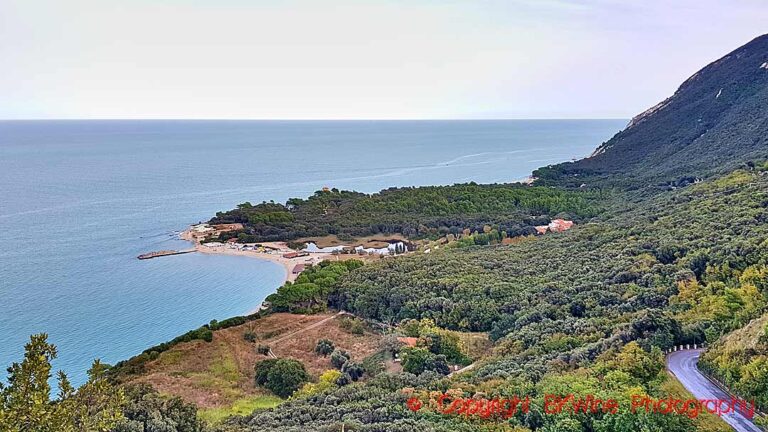The wine festival for wine “made in Sweden” in Skepparp
My wife and I usually go down to Skåne, Scanie, the very south of Sweden, at least once a year to visit grandchildren and other relatives. When we planned the trip for the summer of 2019, I noticed that while we were in Skillinge in Skåne, a wine festival would take place in Skepparp, not far from us. The event looked interesting so why not book both tickets and a table for a Tareq Taylor lunch which was promised to go well with most wines?
Friday, July 26 started out warm and we went to Skepparp so early that we were there when it opened and were let in onto one of the fields that constituted the parking space. The fair was held on a field where each producer had their own tent which gave some protection from the sun. In total, there were 9 producers represented. In addition, there was a wine tasting school headed by Anders Öhman of the Gustibus Wine & Spirit Academy.
Our walking around the fair went smoothly despite increasing congestion. The outdoor environment had the advantage of not needing a spittoon. The meadow grass willingly swallowed all liquids.
Well-made white wines, but…
In total, there were about 40 wines to try, most still and white, made from the solaris grape, but also rosés, sparkling and reds were among the bottles.
In short, my impression was that the white wines were almost without exception very well made, which showed a serious approach to making wine which was also confirmed in the conversations with the growers.
The Solaris wines were fresh with plenty acidity with a sugar content that balanced the acidity. Most of them were from the 2018vintage, which in Sweden was unusually warm and gave a high degree of ripeness in the grapes.
The white wines were usually aged on steel tanks, sometimes on their yeast lees and sometimes with the addition of oak. Reds and rosés were more often aged on new or old oak barrels.
The red and the rosé wines were usually made from rondo, regent, and cabernet cortis grapes or cuvées of them. In some cases, siramé and bolero were used.
With one exception (see below) the red wines did not impress me. The rosé wines were clearly better, almost on par with the whites.
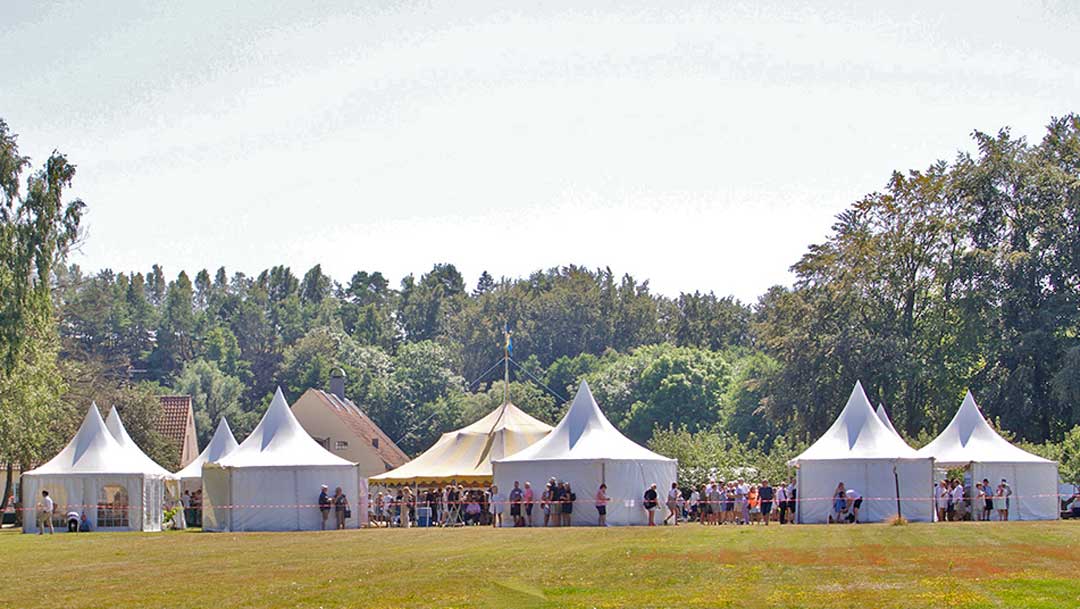
Vine growing and winemaking in Sweden, an overview
Before I go to the exhibitors and the individual wines, it may be appropriate to give a little bit of background on wine growing and grapes in Sweden.
Although Sweden is a country with old and well-developed statistics for most things, the area of viticulture is almost a white spot. The last inventory was made by the Swedish Board of Agriculture in 2009 and a new one is said to be in progress. Some associations of growers exist but are not exhaustive from what I could see. However, the association Swedish Wine seems to include most growers and also has a good map with links to the vineyards. Another good map and links can be found at www.vinvagen.se.
“The Beverage Industry Report” published in both 2018 and 2019 contains some important information on wine, among other things, that in total in Sweden there are about 40 growers who run their business on a commercial basis. In addition, there are several hundred growers who are considered to be hobby growers. Several of these will surely become commercial in the coming years.
However, the total area of cultivation is not larger than about 100 ha planted vineyards. The industry is small-scale.
It is not only in the southernmost part of Sweden that we find winegrowers, but some are also found as far up as in the Mälardalen (Blaxsta, just south-west of Stockholm), on Gotland and on Öland and around Vättern. Some have combined wine growing with apple growing and makes drinks from both fruits.
Starting a company in the beverage industry with commercial production and sales of alcoholic beverages is associated with a lot of bureaucracy in Sweden; up to as many as 50 permits may be required. In Germany, some three are needed…
The EU gave a green light for wine production in Sweden in 1999, which requires, among other things, the use of grape varieties of the species Vitis vinifera and that it has a so-called “plant passports” (see below)
When talking about “Swedish” grapes you often hear the term PIWI. This is simply an acronym that stands for fungal persistence in German, “Pilzwiederstandsfähig”.
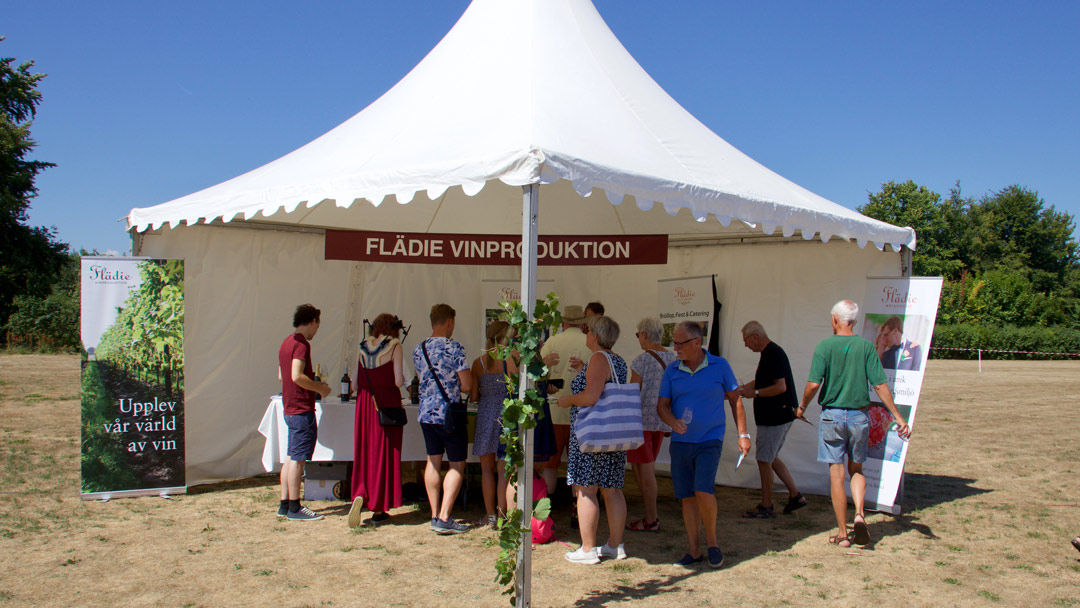
Growing Conditions
This brings me to the conditions for winemaking in Sweden.
Traditional grape varieties of the Vitis vinifera species, such as cabernet sauvignon, syrah, chenin blanc, etc, require a fairly long growing season with a warm daytime. The vine usually requires at least 10 degrees daily average temperature to develop and sufficient heat is also needed for the grape to reach proper maturity so that it can be harvested when the balance between acidity and sugar is optimal. One usually talks about 100 days between budding and maturation.
Sweden, including southern Sweden, has a short growing season, uncertain rainfall, the risk of frost both in spring and in autumn, and autumn rain, all factors that speak against wine growing with traditional grapes.
However, there are other branches on the Vitis tree. One such is Vitis labrusca, which grows wild, for example in North America. It may well have been such a grape that is found in the stories of Leif Ericson. This grape tolerates northern climates better than vinifera and has better resistance to fungal and other diseases that easily affect vinifera. When it comes to the taste, wines made from labrusca have a character that is usually called “foxy”.
Another hardy species is Vitis amurensis which comes from the border regions of China and Siberia and is therefore naturally cold resistant.
The genus Vitis is a branch of the family tree Ampelidae (hence ampelography, the science of the vine) or Vitaceae, which has 10 genera of which 5 have grapes.
It is important to know and understand how different species of wine develop and how the propagation of the vine plant occurs. The vine is hermaphrodite but the propagation is today mainly vegetative, ie by grafting or through cuttings to minimize the occurrence of changes. New rootstocks are thus formed by planting cuttings, and by grafting on “safe rootstocks” the fruit-bearing part of the vine is propagated. You can therefore in principle choose to graft different grape varieties on rootstocks that have good resistance to different diseases or attacks. One example is the wine lice, phylloxera, which, towards the end of the 19th century, destroyed almost all vineyards in Europe. Replanting has been done by grafting on American rootstocks that have greater resistance to phylloxera.
If the vine is allowed to develop freely, sexual reproduction occurs (pollination), which may result in a new plant of the same grape variety but a variant of the original grape variety, another clone. If pollination occurs between two vinifera grape varieties we get a crossing and if it is between two Vitis species we get a hybrid.
In Germany, which has a northern location in the wine world, various universities have since the 1960s been engaged in trying to develop grape varieties that are resistant to mainly fungal diseases, hence the term PIWI mentioned above. But it has also been based on an effort to use the good qualities of high-quality grape varieties, such as riesling, and transfer them to new grapes appropriate for cold climates. Many crossings have been made to this end, some with species other than Vinifera, which give rise to so-called hybrids, which are not allowed under current European wine legislation.
For some successful crossings, the “proportion” of non-vinifera grape material has been so small that the grape is allowed as a vinifera variety and thus can be used in production and sales in Europe. The permitted grape varieties get so-called “plant passports” from the nurseries that produced them. Germany has important such establishments in Freiburg and Heidelberg.
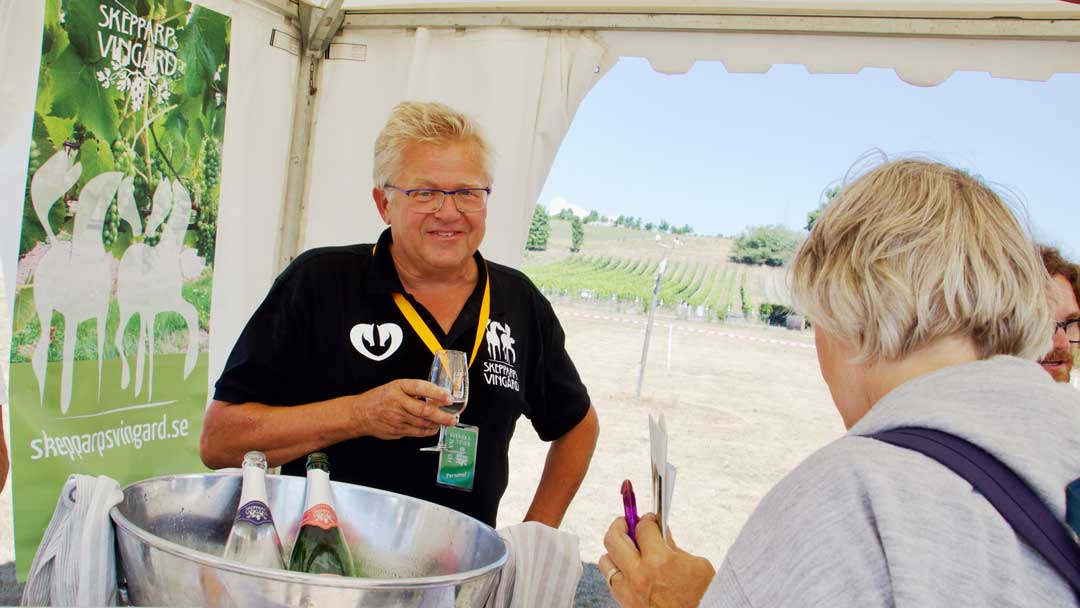
The wine festival in Skepparp
With this background, back then to the wine festival in Skepparp.
These were the exhibitors:
- Flyinge winery, 4 white and 1 orange wine
- Flädie wine production, 2 sparkling white / rosé, 2 white, 2 rosé, 1 red
- Klagshamn Winery, 2 rosé, 3 white and 1 orange
- Fredholm winery, 1 white, 1 red
- Skepparps winery, 2 sparkling white / rosé, 1 white, 1 rosé, 1 red
- Domain Sånana / Skillinge winery, 2 white, 1 red
- Snårestad winery, 2 white, 2 orange, 1 red
- Åhus Winery, 2 whites, 1 rosé
- Österlen Wine, 1 white, 1 rosé
Of these, I first want to comment on the red exception, namely Domän Sånana’s Croix Fleurie Sopasså 2018, which is made from siramé, regent and cabernet cortis and produced with appassimento technology, ie the grapes have been allowed to dry, then pressed and macerated for 28 days. The wine has then been aged on a steel tank with French oak chips for 3 months. The malolactic fermentation was interrupted to retain some of the sharper malic acid (1.3 g).
The wine was flavourful with a good structure and stayed long on the palate. “Peculiar” character. Can be purchased via so-called direct import at Systembolaget.
In a pinch for sales in Sweden
Today, Swedish wine producers can only sell their wines in Sweden via Systembolaget or in a restaurant.
If we look at what is available at Systembolaget, it is also an illustration of how the company works today. The volumes from Swedish producers are too small so there is nothing in the regular range. On the other hand, you can find the wines in local ranges in the shops that are close to the producer. This is where you must go instead of being able to buy directly at the winery when you are there and tasting it.
Nevertheless, most of the wines that are available locally can also be ordered through the Systembolaget, and that’s good. When this is written in October 2019, I found 32 whites, 15 rosés, 5 reds and 8 sparkling wines in the range.
Of the whites, about 20 can be ordered to other monopoly outlets. The wines are predominantly made from solaris. Of the reds, few can be ordered, and of the sparkling, few are made from grapes.
However, one sparkling apple wine (which was not present at the festival) is definitely very drinkable. Bedstekilde Brut Natur 2017, no 94033, 249 kr. It was released on 18/10 in a small quantity in the importers’ on-order range.
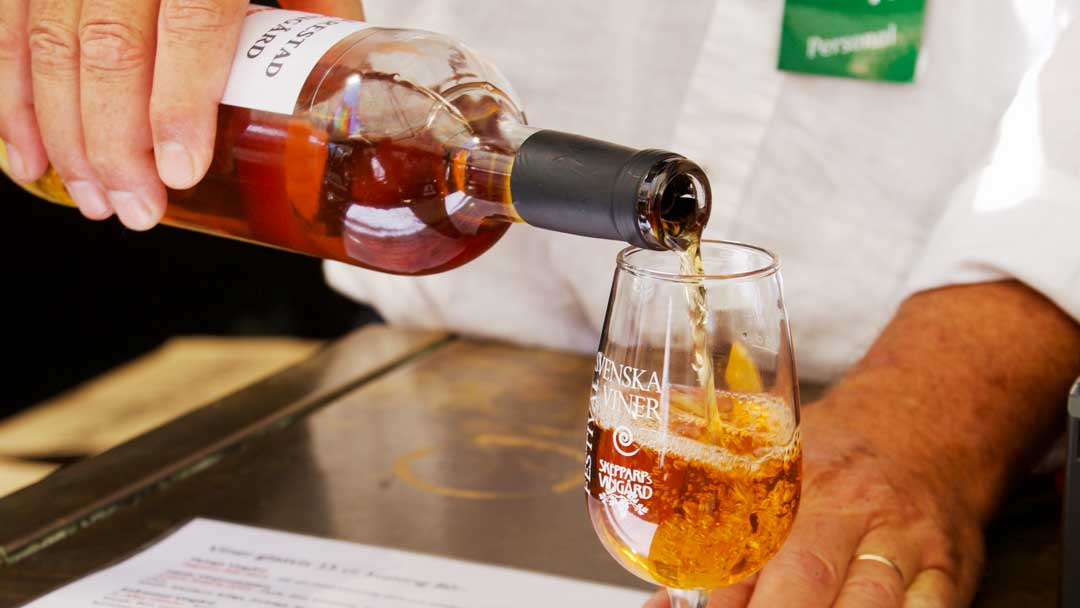
The Swedish Wines
Of the wines I tasted at Skepparp and which I found to be particularly recommendable, the following are available today at the Systembolaget shops:
Pegasus Original 2016, 31141, SEK 227 from Flyinge winery. The wine is aged on a steel tank and used French oak barrels, half each, it has freshness, good structure, and is medium-bodied
Also from Flyinge comes Pegasus Fat 2016, 33096, SEK 265, which was fermented and aged for 8 months in new French oak barrels. The wine, just like the previous one, is fresh with good structure but is fuller-bodied and has a more obvious barrel character.
More wines from Flyinge winery are available at the monopoly, including an orange wine Pegasus Ambra 2018, 33942, 50 cl 155 SEK, with its very own character.
Lucky Star by Jason & Jesper 2018, 33728, SEK 229, from Vingården in Klagshamn, was tasty with some fruit sweetness in addition to the acidity. The wine is made from the solaris grape and fermented on a steel tank for 6 months. The winery also offered a rosé with good structure that was aged for 6 months on steel tank, including 1 month with oak cubes, Lucky Star Rosé by Jason & Jesper, 33732, 150 SEK 50 cl.
Grand Prix Solaris 2018, 33741, SEK 149, 50 cl, also from the Skepparps Vineyard, with freshness, good structure and plenty of flavour from a good year. Aged on steel tank.
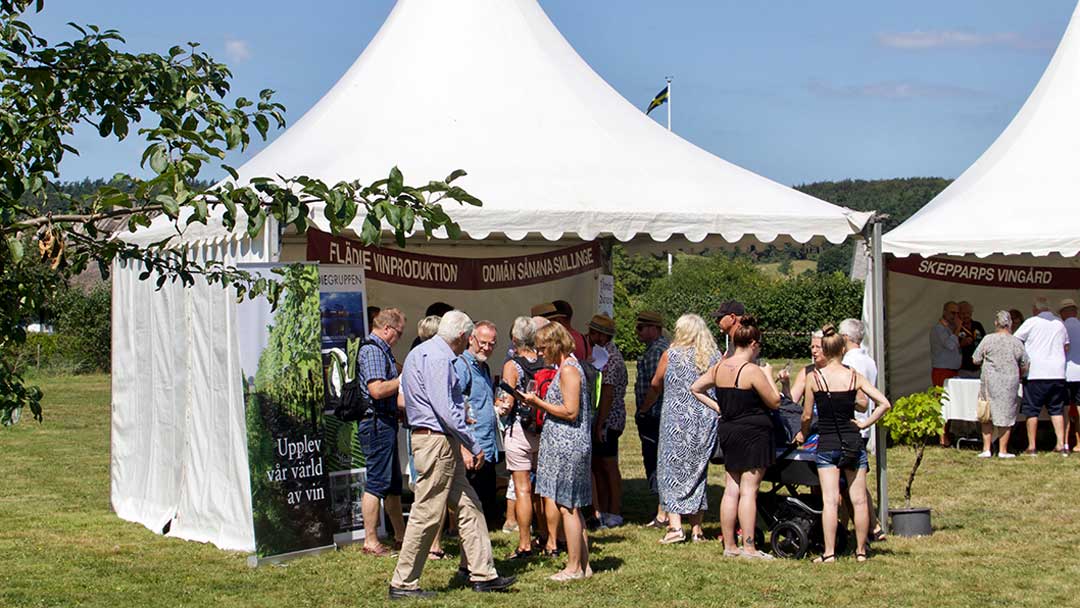
Another wine from the hot summer 2018 is Elsa 2018, 33832, 267 SEK, 50 cl, with a lot of fruit and fresh taste with good structure. The wine had been fermented with oak and aged in steel tank and comes from Fredholm Vingård in Åhus.
Österlen Wine was represented, among other things, by Per Ols Vida 2018, 78304, SEK 226, a very flavourful wine with good acidity from the solaris grape, both fermented and aged in steel tank.
Flädie Wine Production was represented by a number of wines, several of which are in the monopoly stores. A favourite was Alice Rosé 2018, 33694, 136 SEK, 50 cl which was fresh and with lots of taste made from rondo and regent and aged on steel tank. Can work well as an aperitif or with salads. Also not to forget, the white Aniara 2018, 33689, SEK 184, a light, fruity wine with good acidity. Aged on steel tank.
Finally from Vingården in Åhus I tasted both Solaris 2017, 31692, 189 SEK, 50 cl, and Solaris EQ 2018, 32959, 195 SEK, 50 cl, where the latter had a little more fruit from the hot year 2018. Both had good acidity and residual sugar contents of 6 g/l. Both aged in steel tanks, but Solaris 2018 had a touch of oak cubes.
If you want to visit these vineyards and taste some wine, I recommend contacting them in advance to check the possibilities. Most people are very accommodating.
There are also opportunities to taste different Swedish wines at a Wine Bodega at Skivarps Gästgivaregård. It functions a bit like an enoteca in France or in Italy, except that you can’t buy the wines and bring them with you home.
Winegrowers in Skåne are not only in the south-east corner, but also close to the towns of Höganäs and Kullen. Here you can find, for example, Arild’s winery and Kullaberg’s winery which are well worth a visit if you get the opportunity.
Swedish wine is here to stay and we wine enthusiasts can help develop this growing niche, not least by pushing our politicians to allow cellar-door sales of wine.
In 2020 there will be another visit to the Wine Festival in Skepparp for me! Book 24-25 July 2020 for Vinfestivalen!
Carl-Erik Kanne is a long time wine enthusiast and fervent wine taster. He reports from wine tastings and wine events in Stockholm for BKWine Magazine.




